Prestressing Effect of Shape Memory Alloy Reinforcements under Serviceability Tensile Loads
Abstract
1. Introduction
2. Materials and Research Idea
2.1. Repair Mortar/Repair Concrete
2.2. Iron-Based Shape Memory Alloy (Fe-SMA)
- Pre-strained Fe-SMA plates, which are directly fixed by Hilti nails at their ends in the bending tension zone of the reinforced concrete components. The subsequent heating produces an external pre-stressed tension strip without any bond to the reinforced concrete [26,28]. With a pre-strain of 2% and after heating to 160 °C and cooling down to room temperature, an initial pre-stress of 300–350 MPa can be achieved [26,29].
- Pre-strained ribbed reinforcing rebars made of Fe-SMAs are applied in grooves in the bending tension zone of a reinforced concrete member. Afterwards the rebars are heated and the grooves are filled with cement-bound materials. Alternatively, the reinforcing bars can be connected to existing reinforced concrete components via an additional layer. In this variant, the pre-stressing element is bonded to the concrete [11,30] (Figure 2a). With a pre-stressing value of 4–6% and after heating to about 200 °C and cooling down to room temperature, an initial pre-stressing value of about 300 MPa can be achieved for a rebar with a diameter of 16 mm [11]. The achievable pre-stressing values are mainly controlled by the degree of pre-straining and the temperature [11].
3. Experimental Program
3.1. Aim of Investigation
3.2. Material Characterization
3.3. Test Specimens and Experimental Setup
4. Test Results
5. Summary and Conclusions
6. Outlook
Author Contributions
Funding
Institutional Review Board Statement
Informed Consent Statement
Data Availability Statement
Acknowledgments
Conflicts of Interest
References
- Zheng, B.; Dawood, M. Fatigue Strengthening of Metallic Structures with a Thermally Activated Shape Memory Alloy Fiber-Reinforced Polymer Patch. J. Compos. Constr. 2017, 21, 4016113. [Google Scholar] [CrossRef]
- Mas, B.; Cladera, A.; Ribas, C. Experimental study on concrete beams reinforced with pseudoelastic Ni-Ti continuous rectangular spiral reinforcement failing in shear. Eng. Struct. 2016, 127, 759–768. [Google Scholar] [CrossRef]
- Debska, A.; Gwozdziewicz, P.; Seruga, A.; Balandraud, X.; Destrebecq, J.F. Prestress state evolution during thermal activation of memory effect in concrete beams strengthened with external SMA wires. Arch. Civ. Mech. Eng. 2020, 20, 142. [Google Scholar] [CrossRef]
- Choi, E.; Cho, S.-C.; Hu, J.W.; Park, T.; Chung, Y.-S. Recovery and residual stress of SMA wires and applications for concrete structures. Smart Mater. Struct. 2010, 19, 94013. [Google Scholar] [CrossRef]
- Tran, H.; Balandraud, X.; Destrebecq, J.F. Improvement of the mechanical performances of concrete cylinders confined actively or passively by means of SMA wires. Arch. Civ. Mech. Eng. 2015, 15, 292–299. [Google Scholar] [CrossRef]
- Suhail, R.; Amato, G.; McCrum, D.P. Active and passive confinement of shape modified low strength concrete columns using SMA and FRP systems. Compos. Struct. 2020, 251, 112649. [Google Scholar] [CrossRef]
- Normenausschuss Bauwesen (NABau) im DIN. EN 1504—Products and Systems for the Protection and Repair of Concrete Structures—Definitions, Requirements, Quality Control and Evaluation of Conformity; German Version; Beuth Verlag GmbH: Berlin, Germany, 2005. [Google Scholar]
- Raupach, M.; Orlowsky, J. Erhaltung von Betonbauwerken. Baustoffe und Ihre Eigenschaften, 1st ed.; Vieweg+Teubner Verlag; GWV Fachverlage GmbH: Wiesbaden, Germany, 2008; ISBN 9783835101203. [Google Scholar]
- Dimmig-Osburg, A. Innovations Based on PCC. AMR 2013, 687, 369–377. [Google Scholar] [CrossRef]
- Orlowsky, J.; Raupach, M. Textile reinforced sprayed mortar for the repair of hydraulic engineering structures. In Concrete Repair, Rehabilitation and Retrofitting III—Proceedings of the 3rd International Conference on Concrete Repair, Rehabilitation and Retrofitting, ICCRRR 2012, Cape Town, South Africa, 3–5 September 2012; CRC Press: London, UK, 2012; pp. 1065–1070. ISBN 9780415899529. [Google Scholar]
- Michels, J.; Shahverdi, M.; Czaderski, C.; El-Hacha, R. Mechanical Performance of Fe-SMA Ribbed Bars for Concrete Prestressing. ACI Mater. J. 2018, 115. [Google Scholar] [CrossRef]
- Alfes, C.; Fingerloos, F.; Flohrer, C. Wesentliche Änderungen in der neuen DAfStb-WU-Richtlinie 2017. Beton und Stahlbetonbau 2018, 113, 11–19. [Google Scholar] [CrossRef]
- Deutscher Ausschuss für Stahlbeton e.V. DAfStb-Richtlinie—Wasserundurchlässige Bauwerke aus Beton (WU-Richtlinie); Beuth Verlag GmbH: Berlin, Germany, 2017. [Google Scholar]
- Knab, F.; Weber, A.; Schweinfurth, J. Sicherer Einsatz von Glasfaserbewehrung im Bauwesen. Beton und Stahlbetonbau 2015, 110, 822–831. [Google Scholar] [CrossRef]
- Curbach, M.; Ortlepp, R. (Eds.) Textilbeton in Theorie und Praxis. In Proceedings of the Tagungsband zum 6. Kolloquium zu Textilbewehrten Tragwerken (CTRS6), Gemeinsames Abschlusskolloquium der Sonderforschungsbereiche 528 (Dresden) und 532 (Aachen), Berlin, Germany, 19–20 September 2011; Technische Universität: Dresden, Germany, 2011; ISBN 9783867802451. [Google Scholar]
- Weiland, S.; Schladitz, F.; Schütze, E.; Timmers, R.; Curbach, M. Rissinstandsetzung eines Zuckersilos. Bautechnik 2013, 90, 498–504. [Google Scholar] [CrossRef]
- Jesse, F.; Curbach, M. Verstärken mit Textilbeton. In 2010 Beton-Kalender: Brücken—Betonbau im Wasser, 99th ed.; Bergmeister, K., Fingerloos, F., Wörner, J.-D., Eds.; Ernst & Sohn Verlag: Berlin, Germany, 2010; pp. 457–565. ISBN 9783433600443. [Google Scholar]
- Shahverdi, M.; Czaderski, C.; Annen, P.; Motavalli, M. Strengthening of RC beams by iron-based shape memory alloy bars embedded in a shotcrete layer. Eng. Struct. 2016, 117, 263–273. [Google Scholar] [CrossRef]
- Schranz, B.; Czaderski, C.; Vogel, T.; Shahverdi, M. Bond behaviour of ribbed near-surface-mounted iron-based shape memory alloy bars with short bond lengths. Mater. Des. 2020, 191, 108647. [Google Scholar] [CrossRef]
- Saiidi, M.S.; Wang, H. Exploratory Study of Seismic Response of Concrete Columns with Shape Memory Alloys Reinforcement. ACI Struct. J. 2006, 103, 436–443. [Google Scholar] [CrossRef]
- Strieder, E.; Aigner, C.; Petautschnig, G.; Horn, S.; Marcon, M.; Schwenn, M.; Zeman, O.; Castillo, P.; Wan-Wendner, R.; Bergmeister, K. Strengthening of Reinforced Concrete Beams with Externally Mounted Sequentially Activated Iron-Based Shape Memory Alloys. Materials 2019, 12, 345. [Google Scholar] [CrossRef]
- Cladera, A.; Weber, B.; Leinenbach, C.; Czaderski, C.; Shahverdi, M.; Motavalli, M. Iron-based shape memory alloys for civil engineering structures: An overview. Constr. Build. Mater. 2014, 63, 281–293. [Google Scholar] [CrossRef]
- Janke, L. Applications of shape memory alloys in civil engineering structures—Overview, limits and new ideas. Mater. Struct. 2005, 38, 578–592. [Google Scholar] [CrossRef]
- Lee, W.J.; Weber, B.; Feltrin, G.; Czaderski, C.; Motavalli, M.; Leinenbach, C. Phase transformation behavior under uniaxial deformation of an Fe–Mn–Si–Cr–Ni–VC shape memory alloy. Mater. Sci. Eng. A 2013, 581, 1–7. [Google Scholar] [CrossRef]
- Dong, Z.; Klotz, U.E.; Leinenbach, C.; Bergamini, A.; Czaderski, C.; Motavalli, M. A Novel Fe-Mn-Si Shape Memory Alloy with Improved Shape Recovery Properties by VC Precipitation. Adv. Eng. Mater. 2009, 11, 40–44. [Google Scholar] [CrossRef]
- Shahverdi, M.; Michels, J.; Czaderski, C.; Motavalli, M. Iron-based shape memory alloy strips for strengthening RC members: Material behavior and characterization. Constr. Build. Mater. 2018, 173, 586–599. [Google Scholar] [CrossRef]
- Niendorf, T.; Brenne, F.; Krooß, P.; Vollmer, M.; Günther, J.; Schwarze, D.; Biermann, H. Microstructural Evolution and Functional Properties of Fe-Mn-Al-Ni Shape Memory Alloy Processed by Selective Laser Melting. Metall. Mater. Trans. A 2016, 47, 2569–2573. [Google Scholar] [CrossRef]
- Vollmer, M.; Arold, T.; Kriegel, M.J.; Klemm, V.; Degener, S.; Freudenberger, J.; Niendorf, T. Promoting abnormal grain growth in Fe-based shape memory alloys through compositional adjustments. Nat. Commun. 2019, 10, 2337. [Google Scholar] [CrossRef] [PubMed]
- Michels, J.; Shahverdi, M.; Czaderski, C. Flexural strengthening of structural concrete with iron-based shape memory alloy strips. Struct. Concr. 2018, 19, 876–891. [Google Scholar] [CrossRef]
- re-fer AG. References. Available online: https://www.re-fer.eu/en/references/ (accessed on 14 December 2020).
- Deutsches Institut für Normung. EN 1015-11 Methods of Test for Mortar for Masonry—Part 11: Determination of Flexural and Compressive Strength of Hardened Mortar; German Version; Beuth Verlag GmbH: Berlin, Germany, 2020. [Google Scholar]
- re-fer AG. Product Data Sheet: Re-Bar. Available online: https://www.re-fer.eu/downloads/ (accessed on 23 November 2020).
- Schranz, B.; Czaderski, C.; Michels, J.; Vogel, T.; Motavalli, M. Ribbed iron-based shape memory alloy bars for pre-stressed strengthening applications. In IABSE Symposium 2019 Guimarães, towards a Resilient Built Environment Risk and Asset Management; International Association for Bridge and Structural Engineering: Zürich, Switzerland, 2019; ISBN 9783857481635. [Google Scholar]
- Normenausschuss Eisen und Stahl (FES) im DIN; Normenausschuss Bauwesen (NABau) im DIN. DIN 488-1 Betonstahl—Teil 1: Stahlsorten, Eigenschaften, Kennzeichnung; Normenausschuss Eisen und Stahl (FES) im DIN; Normenausschuss Bauwesen (NABau) im DIN: Berlin, Germany, 2009. [Google Scholar]
- DIN German Institute for Standardization. Eurocode 2: Design of Concrete Structures—Part 1-1: General Rules and Rules for Buildings; German Version EN 1992-1-1:2004 + AC:2010; Beuth Verlag GmbH: Berlin, Germany, 2011. [Google Scholar]
- Schranz, B.; Figueiredo Nunes, M.; Czaderski, C.; Shahverdi, M. Bond modelling of near-surface-mounted memory-steel bars for prestressing based on fiberoptic strain measurements. Constr. Build. Mater. 2020. In Review. [Google Scholar]


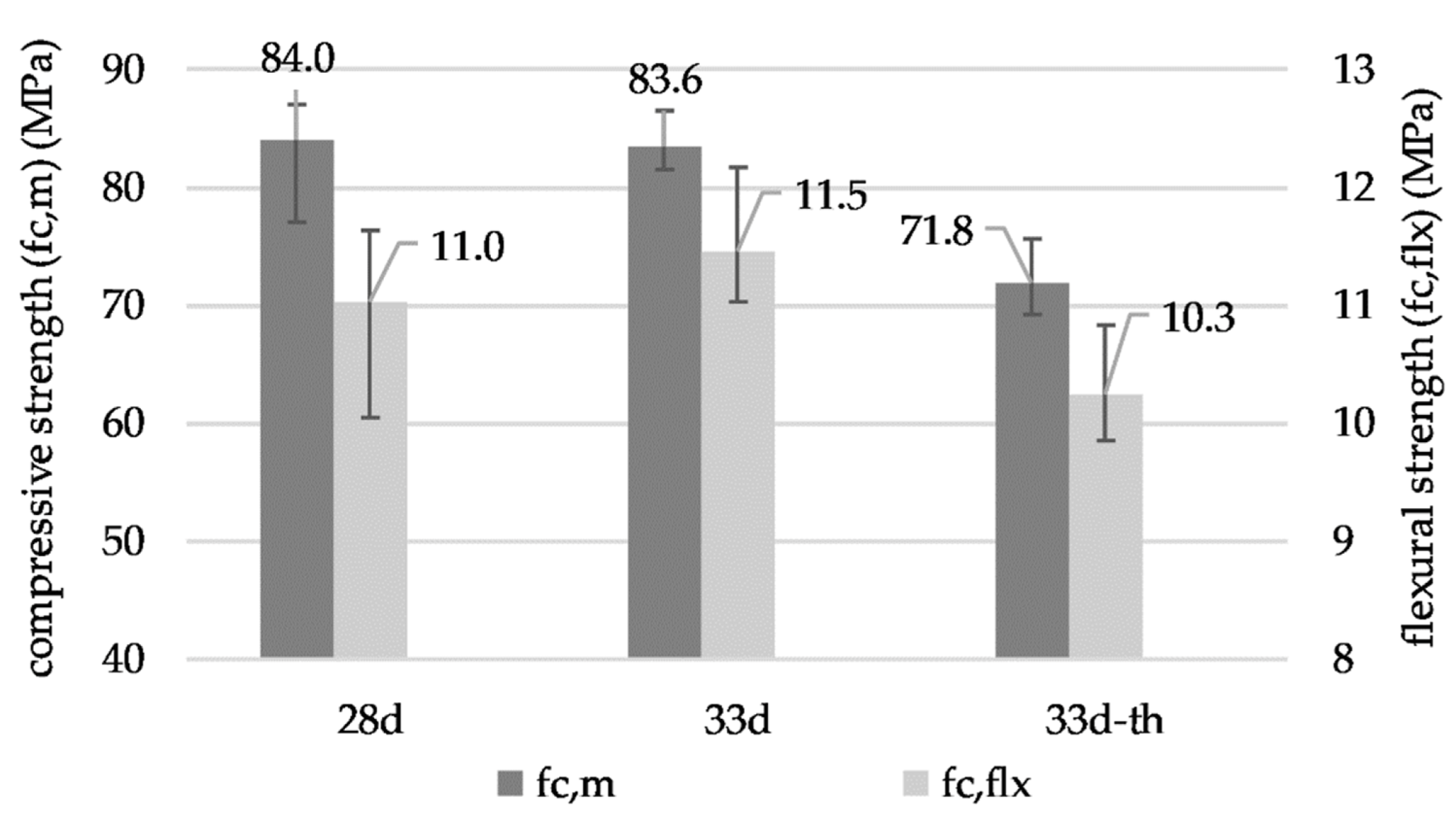
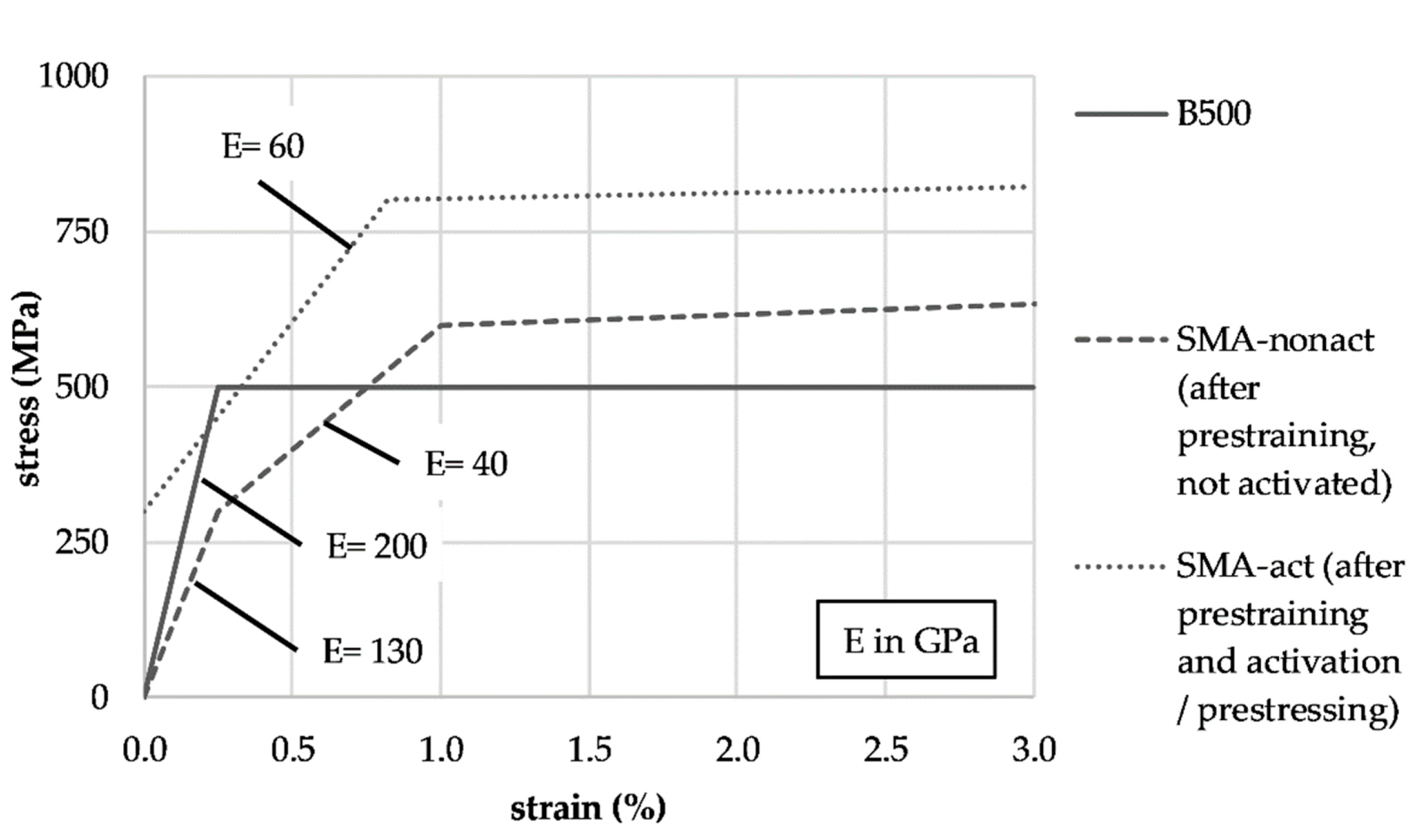
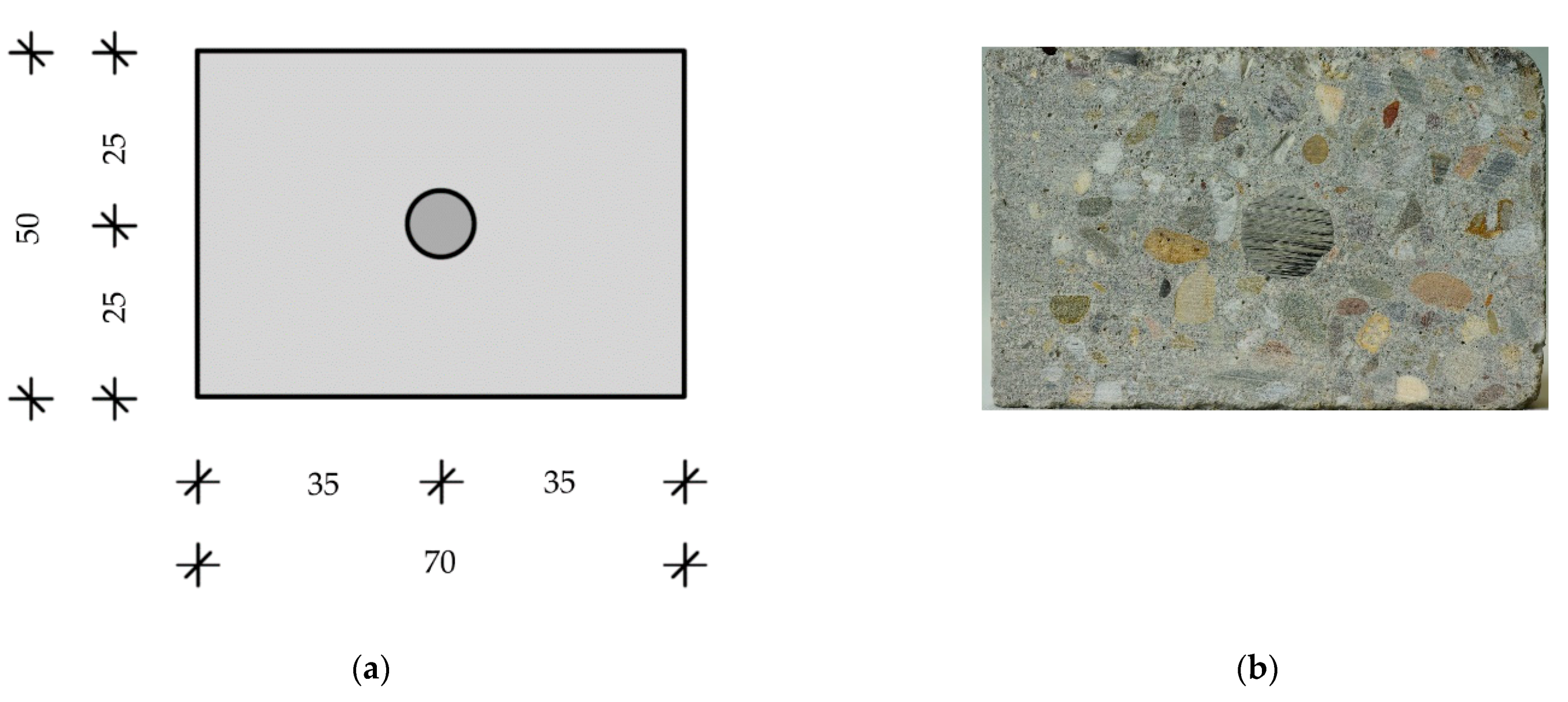

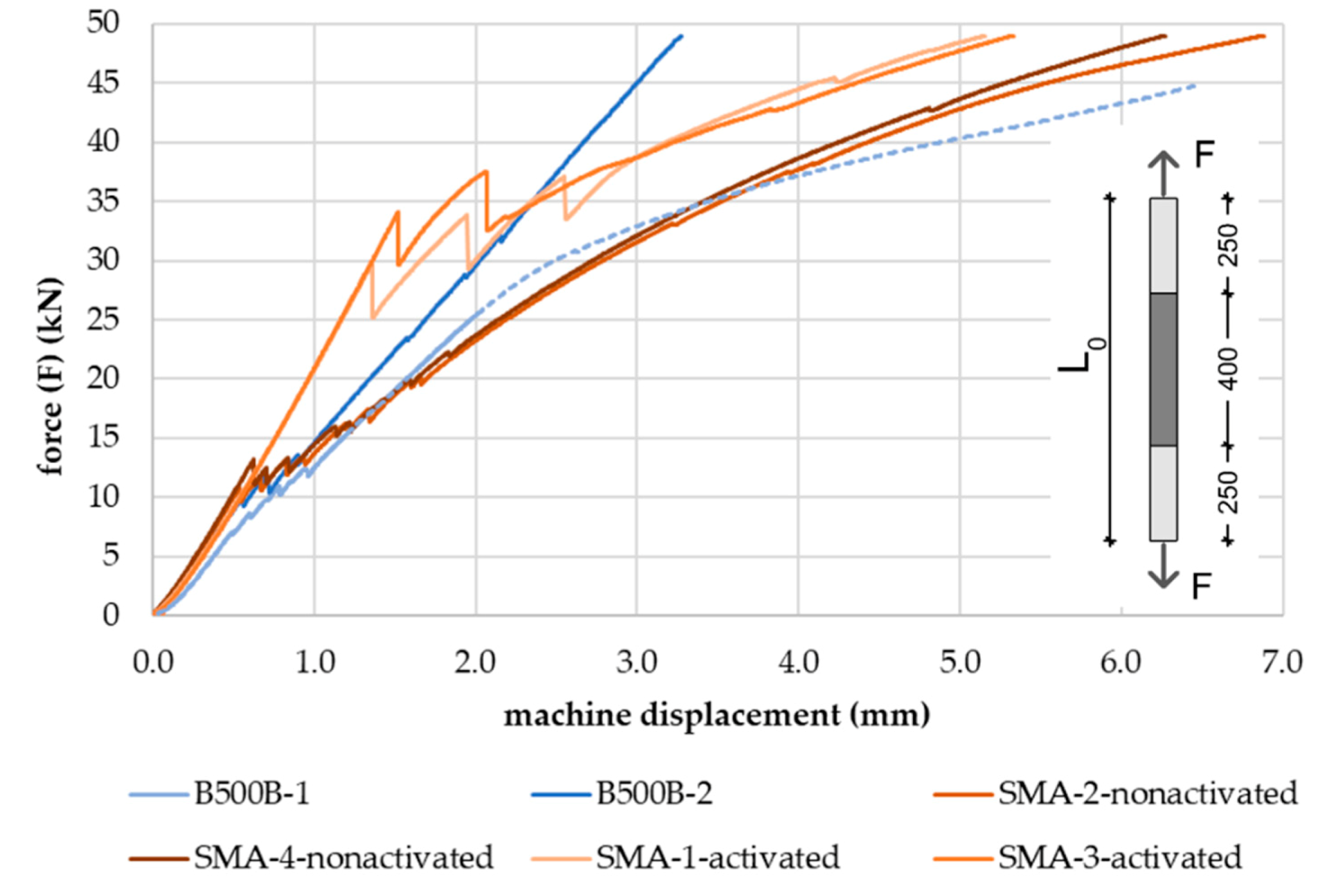
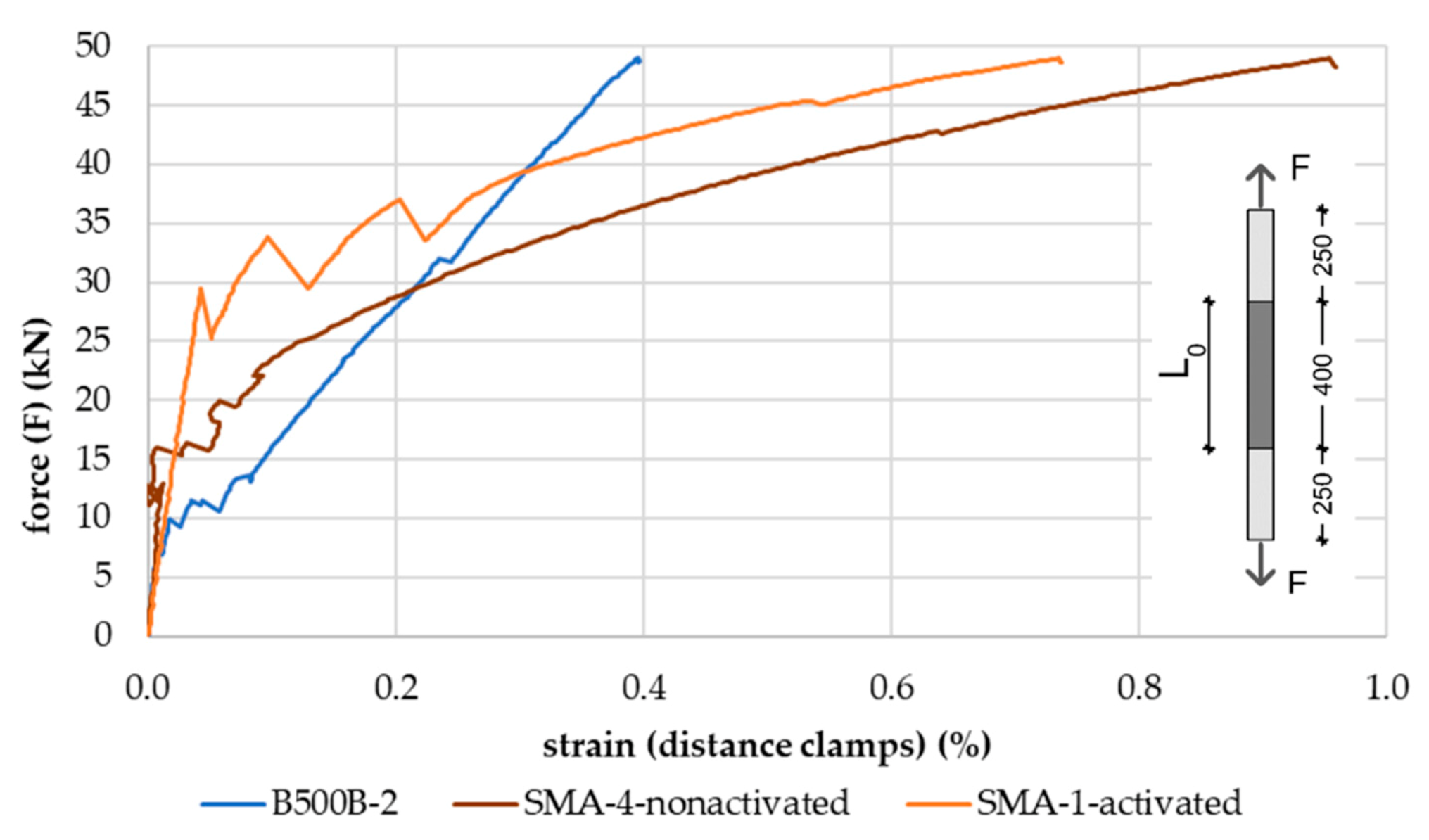

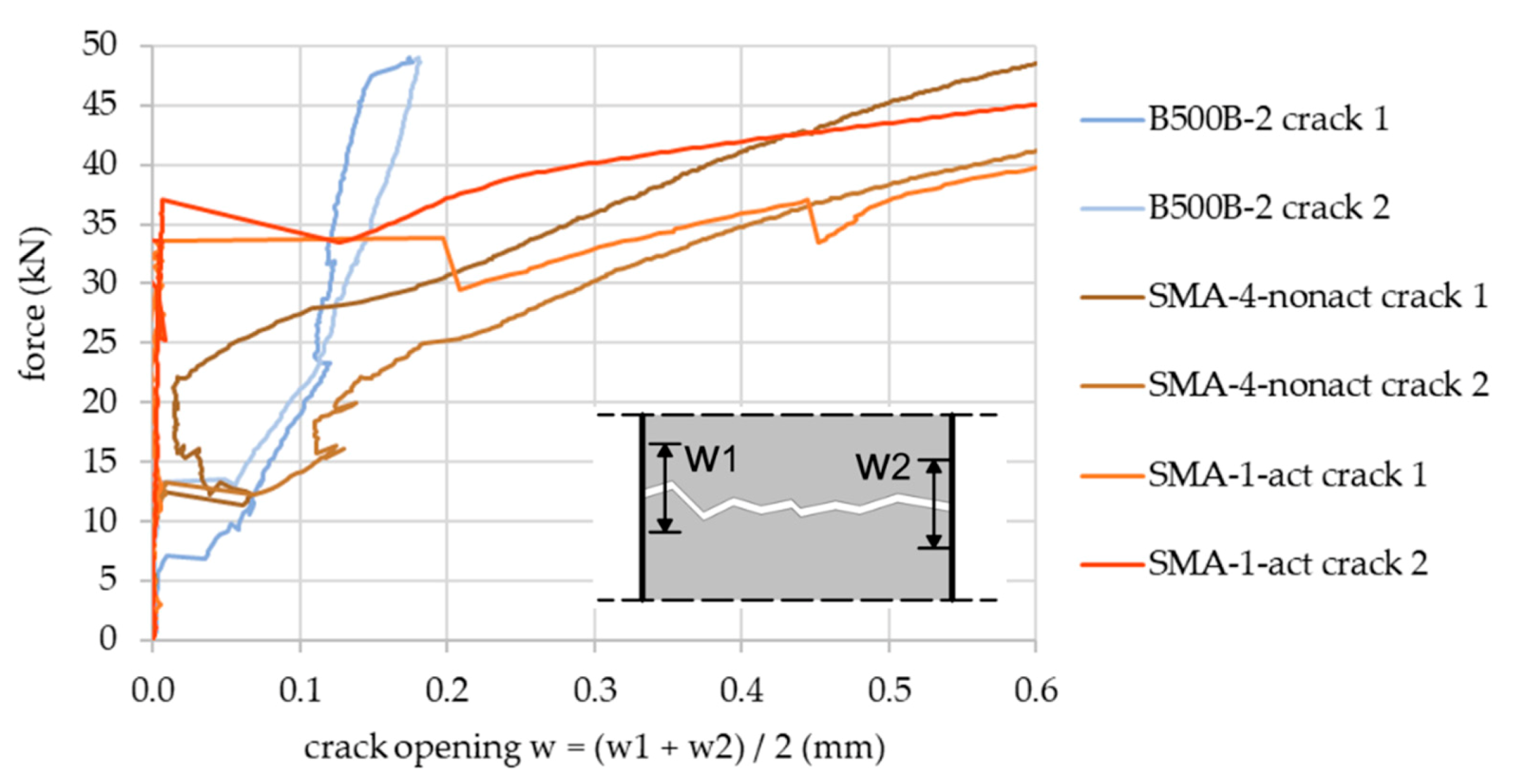
| Component | Unit | Amount |
|---|---|---|
| Cement CEM I 42.5 R (c) | kg/m³ | 480 |
| Water content (w) | 205 | |
| Filler | 114 | |
| Sand 0–2 mm | 652 | |
| Gravel 2–8 mm | 864 | |
| Super-plasticizer | %/c | 0.5 |
| w/c-ratio | - | 0.42 |
| Reinforcement | Unit | Construction Steel [34] | FE-SMA Rebar [32] | |
|---|---|---|---|---|
| Prestrained Activated | Prestrained Nonactivated | |||
| Abbreviation | - | B500B | SMA | |
| Tensile strength | MPa | 540 | 650 | |
| Young′s modulus | GPa | 200 | 170–60 | 130–40 |
| Diameter (mm) | mm | 12 | 11 | |
| Nominal cross section (A) | mm² | 113 | 105 | |
| Percentage of reinforcement | % | 3.2 | 3.0 | |
Publisher’s Note: MDPI stays neutral with regard to jurisdictional claims in published maps and institutional affiliations. |
© 2021 by the authors. Licensee MDPI, Basel, Switzerland. This article is an open access article distributed under the terms and conditions of the Creative Commons Attribution (CC BY) license (http://creativecommons.org/licenses/by/4.0/).
Share and Cite
Beßling, M.; Czaderski, C.; Orlowsky, J. Prestressing Effect of Shape Memory Alloy Reinforcements under Serviceability Tensile Loads. Buildings 2021, 11, 101. https://doi.org/10.3390/buildings11030101
Beßling M, Czaderski C, Orlowsky J. Prestressing Effect of Shape Memory Alloy Reinforcements under Serviceability Tensile Loads. Buildings. 2021; 11(3):101. https://doi.org/10.3390/buildings11030101
Chicago/Turabian StyleBeßling, Markus, Christoph Czaderski, and Jeanette Orlowsky. 2021. "Prestressing Effect of Shape Memory Alloy Reinforcements under Serviceability Tensile Loads" Buildings 11, no. 3: 101. https://doi.org/10.3390/buildings11030101
APA StyleBeßling, M., Czaderski, C., & Orlowsky, J. (2021). Prestressing Effect of Shape Memory Alloy Reinforcements under Serviceability Tensile Loads. Buildings, 11(3), 101. https://doi.org/10.3390/buildings11030101








